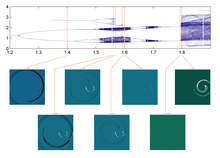한국어 개요
Outline of Korean language다음 개요는 한국어 개요 및 시사 가이드로 제공됩니다.
한국어는 약 8천만 [1]명의 사람들이 사용하는 동아시아 언어이다.한국어 어족에 속하며 남북한의 공식 언어이자 국가 언어이다.북한과 남한은 서로 다른 표준화된 공식 양식을 사용한다.중국 지린(吉林)성 옌볜(延 korean)조선족자치주와 창바이(長白)조선족자치현의 두 공용어 중 하나다.역사 및 현대 언어학자들은 한국어를 [2][3][4][5][6][7]고립된 언어들로 분류하지만, 한국어 자체와 제주어와 함께 한국어의 어족으로 간주되는 몇 개의 멸종된 친척들이 있다.이는 한국인이 고립된 존재가 아니라 미시적 가족의 일원임을 시사한다.한국어가 논란이 되고 있는 알타이어족에 속한다는 생각은 학술 연구에서 [8][9]신빙성을 잃는다.한국어는 형태학에서 응집적이고 구문론에서 SOV이다.
한국어 –
한국어는 어떤 종류의 언어인가요?
한국어는 다음과 같이 설명할 수 있습니다.
한국어 방언
한국어의 역사
일반적인 한국어 개념
- 한국어 카운트워드
- 한국어 방언
- 한국어 문법
- 한국어와 컴퓨터
- 한글 자모
- 한글 숫자
- 한국의 조사
- 한국의 불경
- 한국어 대명사
- 한글 구두점
- 한국어 수준
- 한국어 동사
- 한국어 음운론
- 한글 명찰 어원 목록
- 한글
- 한자
- 한국어 존댓말
국어사전
한글
- 시아어
- 동국정운
- 한글
- 한글날
- 한글 패권
- 한글음절
- 훈민정음
- 훈민정음 해례
- 훈민정음학회
- 한글 서예
- 한국어학회
- KS X 1001
- 국립한글박물관
- 한글의 기원
- 한글 맞춤법
- SKATSKATS
- 타이완 한글
- 통일 한글 코드
- 용비어천가
한국어 단체
한국어 매체
한국어 서적
만화
국어 백과사전
한국어 웹사이트
한국어에 영향력 있는 사람들
코리안리스트
- 알렉산드르 아르귀엘레스
- 찰스 K.암스트롱
- 로버트 버스웰 주니어
- 양희최월
- 모제스 초마
- 마르티나 듀츨러
- 카터 에커트
- 대한민국 백과사전
- 제임스 스카스 게일
- 스테판 해거드
- 제임스 호어
- 러시아의 조선족 목록
- 니콜라이 쿠에너
- 안드레이 란코프
- 존 윌슨 루이스
- 프레드 루코프
- 조지 맥쿤
- 로버트 M.오펜하임
- 콜 오타 심페이
- 박노자
- 제임스 팔레
- 키스 프랫
- 스티븐 리비어
- 리처드 러트
- Andre Schmid (학술)
- 윌리엄 E.스킬 엔드
- 로저 테넌트
- 셈 베르메르슈
한영 번역자
한국어 단어와 구절
- 한국어 유래 영어 단어 목록
- 애교
- 아줌마
- 안주(음식)
- 박지원
- 빵(한국어)
- 보자기
- 본관
- 보슬라치
- 뷰롬
- 변사
- 재벌
- 동아시아 언어의 화학 원소
- 친일파
- 첨추럼
- 대보름
- 도복
- 도깨비
- 웁신
- 한국 화폐의 어원
- 기러기 아파
- 고곡
- 공산당
- 고수
- 궁민당
- 귀신
- 계양
- 한(문화)
- 한옥
- 헬조선
- 호미(도구)
- 호패
- 화병
- 화랑
- 현
- 형
- 인민반
- 재생
- 진보당
- 쪽바리
- 깡패
- 콘미남
- 만화방
- 민정
- 목옥탕
- Mu(음수)
- 문전본풀리
- 남한
- 남산
- 노동당
- 난치
- 대기중
- 판소리 고수
- PC방
- 한글 명찰 어원 목록
- 평
- 삼포 세대
- 선비
- 심검도
- 신민당
- 소셜테이너
- 소각
- 소정화
- 선군
- 씨름
- 태극
- 탈춤
- 만년
- 탁미리
- 투전
- 얼짱
레퍼런스
- ^ Summary by language size, table 3
- ^ 를 클릭합니다Song, Jae Jung (2005), The Korean language: structure, use and context, Routledge, p. 15, ISBN 978-0-415-32802-9.
- ^ 캠벨, 라일, Mixco, 마우리시오(2007년),"한국, 한 언어를 고립시키", A용어 사전 역사 언어학, 유타 대학 출판부,를 대신하여 서명함. 7, 90–91, 대부분의 전문가들...더 이상은 믿어요Altaic 그룹...있나 한국[…]종종 일본어는 종종 또한과Altaic 가설에 속하는 것을 이 널리 지지를 받지 못 할 수 있다고 한다 관련되어 있다.
- ^ 를 클릭합니다Dalby, David (1999–2000), The Register of the World's Languages and Speech Communities, Linguasphere Press.
- ^ 를 클릭합니다Kim, Nam-Kil (1992), "Korean", International Encyclopedia of Linguistics, vol. 2, pp. 282–86,
scholars have tried to establish genetic relationships between Korean and other languages and major language families, but with little success
. - ^ 를 클릭합니다Róna-Tas, András (1998), "The Reconstruction of Proto-Turkic and the Genetic Question", The Turkic Languages, Routledge, pp. 67–80,
[Ramstedt's comparisons of Korean and Altaic] have been heavily criticised in more recent studies, though the idea of a genetic relationship has not been totally abandoned
. - ^ 를 클릭합니다Schönig, Claus (2003), "Turko-Mongolic Relations", The Mongolic Languages, Routledge, pp. 403–19,
the 'Altaic' languages do not seem to share a common basic vocabulary of the type normally present in cases of genetic relationship
. - ^ Sanchez-Mazas; Blench; Ross; Lin; Pejros, eds. (2008), "Stratification in the peopling of China: how far does the linguistic evidence match genetics and archaeology?", Human migrations in continental East Asia and Taiwan: genetic, linguistic and archaeological evidence, Taylor & Francis
- ^ Vovin, Alexander. "Korean as a Paleosiberian Language (English version of 원시시베리아 언어로서의 한국어)".
{{cite journal}}:Cite 저널 요구 사항journal=(도움말)


